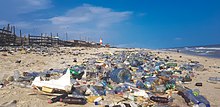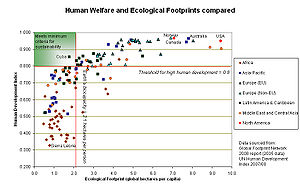Global environmental inequality refers to "the expression of an environmental burden that would be borne primarily by disadvantaged and /or minority populations or by territories suffering from a certain poverty and exclusion of these inhabitants." Global environmental inequality is an issue that affects both developing and developed countries across the globe.
Environmental racism
The relationship between environmental racism and environmental inequality is recognized throughout the developed and developing world. An example of global environmental racism is the process in which the locations of hazardous waste facilities are higher in vulnerable communities compared to that of other areas. This is most commonly seen in the USA as the environmental racism gap is very prevalent in many states across the country. Environmental racism raises ethical issues but can also have implications for a state's laws and constitution, for example the “clean air act”, “the fourteenth amendment” and the “civil rights act”.
An example of a case of environmental racism is a small mainly African American (90%) town called Uniontown located in Alabama where there is a toxic landfill which is believed to have caused serious health issues in the area. Concerns include things such as mental health issues, a one-in-five chance of developing cancer and deficiencies in reproduction due to the toxins such as mercury and arsenic contained within the ash. The toxic landfill is used to dump millions of tons of coal ash which comes from mainly white wealthier areas. Uniontown is not an isolated case as it can be seen there are many examples across the states such as Flint Michigan who are dealing with a major water crisis, West Dallas Texas where African American housing projects have been set up twenty paces from a battery recycling smelter, and Chester Pennsylvania which has become an attraction for toxic waste sites. In California the government also decided to allow pollution in vulnerable communities. The effect of environmental racism is seen in the health data which shows that African Americans are three times more likely to die from asthma. Three out of five African Americans live in a community with a least one toxic waste site. On average it takes twenty percent longer for toxic sites in minority community towns to be placed on the national priority list than white areas.
Environmental racism is not only seen in the developed world but it is also prevalent in the developing world. Much hazardous waste in Africa is not actually produced there but rather was exported by developed countries such as the U.S; even though much of this exportation of waste took place in the 1980s Africa is still left with the problem of toxic waste sites to this day.
Income inequality
The relationship between economic inequality and environmental inequality plays a large roll in understanding certain reasons that account for the cause of environmental inequality. The association between income inequality and environmental inequality can be measured by the environmental Kuznets curve. This curve states that when income per capita is high, the rate of pollution in that area rises until income reaches a certain threshold, once this threshold of wealth is passed then pollution in that area begins to decrease. In the case of developing nations an increase in pollution and production of greenhouse gases occurs as that nation undergoes economic growth, therefore for developing nations to escape poverty through growth pollution must be produced. This pollution is often caused through industry and manufacturing. Once the developing nation becomes a developed nation then we begin to see a drop off in pollution as a better alternative to high pollution industry can be found to stimulate the economy. Renewable energy has been more expensive to produce and maintain than traditional energy produced by fossil fuels and has only recently become as cost efficient as fossil fuels. Since the discovery of greener energy sources only richer developed nations have been able to invest and integrate renewable energy into their power production industries.
In countries such as Russia it has been found that in areas where income was higher that there was an increase in uncontrolled air pollution. However while income may have been higher in these regions a greater disparity in income inequality was found. It was discovered that "greater income inequality within a region is associated with more pollution, implying that it is not only the level of income that matters but also its distribution". In Russia areas lacking in hospital beds suffer from greater air pollution than areas with higher numbers of beds per capita which implies that the poor or inadequate distribution of public services also may add to the environmental inequality of that region.
Another consequence of income inequality's association with environmental inequality is the environmental privilege of consumers in developed countries, "consumers of goods and services that are produced by polluting industries [who] often are spatially and socially separated from the people who bear the impacts of the pollution". Those who are working in the production of consumer goods suffer a disproportionate amount the consequences of environmental deterioration that their more affluent consumer counterparts.
Inequality in the United States
In the United States it was also found that income inequality greatly affected the quality of the environment in which people live. People of colour and the poor in America on average experience much lower quality environments then white people or the wealthy. Action was taken in the early 1990s by the American Government in an attempt to improve environmental quality for poorer regions. In 1992 the United States Environmental Protection Agency set up the Office of Environmental Equity, now known as the Office of Environmental Justice, to address the situation at hand. However the Office of Environmental Justice's work was undermined by Congress who refused to pass the bills which were presented to them by the EPA. Instead states began to pass their own bills which did very little to improve environmental quality for poorer areas. As a result, there has been little to no change in the ratios of environmental inequality whereas there has been a decline in the ratios of race and poverty.
Environmental change in developing countries
Global environmental inequality is primarily seen in developing countries. In recent years we have seen a change in China's production industry in relation from the movement from the primary sector of production moving into the secondary sector. China's urbanization has caused a rise in the production of factories. In China factories create harmful waste such as nitrogen oxide and sulfur dioxide which cause health risk. Journalist and science writer Fred Pearce notes that in China "most monitoring of urban air still concentrates on one or at most two pollutants, sometimes particulates, sometimes nitrogen oxides or sulfur dioxides or ozone. Similarly, most medical studies of the impacts of these toxins look for links between single pollutants and suspected health effects such as respiratory disease and cardiovascular conditions." The country emits about a third of all the human-made sulfur dioxide (SO2), nitrogen oxides (NOx), and particulates that are poured into the air around the world. The Global Burden of Disease Study, an international collaboration, estimates that 1.1 million Chinese die from the effects of this air pollution each year, roughly a third of the global death toll." The economic cost of deaths due to air pollution is estimated at 267 billion yuan (US$38 billion) per year.
Climate change and environmental inequality
The main issue faced by developed countries in the western world is climate change. Climate change and its effects are being escalated due to the actions of many developed countries. The use of fossil fuels has resulted in an increase of atmospheric carbon dioxide by 33% in the past 150 years. However, the effects of climate change will be worse in areas with less food security. Due to the changes in temperature and precipitation, combined with the increase in levels of greenhouse gases emitted, it is becoming more and more difficult to produce sustainable crops. This dangerous combination leads to constant fluctuating levels of trade. The main causes of short-term fluctuations in food production are natural disasters, such as drought and floods. When climate fluctuations become more prevalent and widespread, extreme natural events will become more severe and more frequent. With the demand for food expected to increase by 50% by 2030 alongside a growing population, food security is becoming vital. In temperate latitudes, higher temperatures are expected to benefit agriculture, as the areas that are potentially suitable for cropping will expand, and the length of the growing period will also increase.
However, with the rise in temperature, comes a rise in extreme events, such as heatwaves which may lead to drought. For example, in the summer of 2018, Ireland experienced the hottest summer on record since 1976. This heatwave lead to a 53 day period of "absolute drought conditions", and as a result, there was an increase in crop failures. The increase in frequency of these extreme events affect the stability of food supplies and thus food security. When food supplies get damaged by weather, access to food also becomes damaged. When developing countries are faced with extreme events, and certain crops can no longer be produced due to sustainability, the access to certain foods, such as cereals and exotic fruits, become unavailable to the people living in developed countries. The areas that will be mostly affected by crop failure are found in sub-Saharan Africa and parts of South Asia. This means that the regions that will be exposed to the highest degree of instability in food production are the poorest regions in developing countries. Climate change will affect all dimensions of food security, in particular food availability, access to food, and stability of food supplies. The overall impact of climate change on food security will affect both developing countries and developed countries, however, the effects will be felt differently across regions and over different periods of time.











